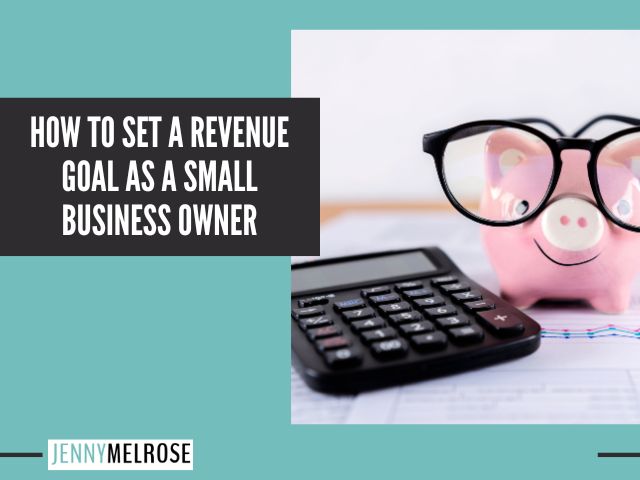Learn practical steps to set a realistic and achievable revenue goal for your small business.
IE 410: How to Set a Revenue Goal as a Small Business Owner

It is great that you are running your own business, but you have to be able to hold yourself accountable and set goals that are going to have revenue in mind.
As a business, you have to be determining your revenue goals.
You cannot simply be saying that you’re going to get more followers, or that you’re going to get more traffic, that is not how you run a business.
You have to be looking at your revenue.
What is a revenue goal?
A revenue goal is an anticipated annual goal for revenue of a business based on previous revenue from past years.
if you were just getting started. I want you to put an anticipated revenue goal that you think you could potentially hit.
You are going to also want to think about that when you are setting your revenue goal that it can be broken down quarterly or monthly in order to stay on top of the goal.
You’re going to hear how those numbers are just so important and that you can’t simply write it down. And then never revisit it.
It’s not going to naturally come to fruition if you’re not going back and checking to see what tasks you put in place are actually helping you hit those goals
It can be broken down quarterly or monthly in order to stay on top of the goal.
Why is a revenue goal important?
A clear revenue goal based on products and/or services helps create a clear path for the focus of a business.
It also allows an opportunity to analyze what has worked in the past and what may need more or less attention.
We’re going to really start to talk about how you can break down your revenue pieces within your business and determine whether or not the amount of energy and time you are putting into certain products or services is right.
You may find that a product that you’ve been putting a ton of time into isn’t quite hitting the right way, isn’t getting the anticipated revenue that you thought it would.
But there might be another product that you have that is doing really well, and you need to look at and determine how you can put more effort into that other product and what has been working so that you can maximize the amount of revenue that can come out of that product or service.
How to set a revenue goal
1. Look at past data broken down by product and/or service
If you are a business owner and you are doing one on one services, or if run a group program, or if you have courses, or if you have a workshop, or if you are doing affiliates, or if you are doing sponsored content, or if you are making maybe money from ads.
I want you to break each of these categories down and determine what you are making for the year and by month.
It’s important that you understand the ebbs and flows of your business.
What products do better during Q4?
When does your time traffic increase revenue for ads?
When does affiliate income really need to have your focus and make sure that you are promoting?
2. Determine which products need your effort
The next thing that you’re going to determine is which products need your effort.
Where can you maximize your time and effort so that if you are already seeing that a product is doing really well, what did that launch look like?
How are you promoting it?
What could you double down on to increase the revenue to that product or service?
And that’s what you’re going to want to make sure you’re looking at here
3. Set goals based on S.M.A.R.T. goals
The third thing you’re going to want to do is set goals based on SMART goals for your revenue.
If we are looking at increasing a course that we have put out, we want the income to increase on that, what were you previously doing?
Could you look at your overall subscribers to your list?
Most likely a large portion of your sales are coming from your email list.
So let’s double down on focusing on that email list that will then convert into sales for that and you want to make sure that you set up smart goals for that.
You can break it down so that you are making sure that they are specific, they are measurable.
They are achievable, they are realistic, and they are time sensitive. That is what SMART goals stand for.
4. Determine the tasks necessary to reach those goals
In the example before, I said that if we were to increase sales because we saw that a lot of our sales were coming from our email list, maybe we’re going to double down on making sure that we’re growing our list.
So, what tasks are we going to do in order to grow that list?
Are we going to potentially do list swaps and collaborate with other people within our niche so that we can grow our list with like minded people that are going to end up in sales for us?
5. Revisit goals monthly to analyze the data
I know as creatives, it can feel very frustrating to have to look at numbers.
That’s normally our least favorite thing to do, but if you are not looking at your numbers, you’re not running your business like a business.
You don’t know whether or not the amount of effort and time you are putting into certain tasks are actually resulting in what you are ideally looking for.
So if you were doubling down on putting your time into Pinterest, is it resulting in sales?
Is it resulting in email subscribers? How are you measuring that?
You need to make sure that you are determining that and looking to see if the effort that you are putting in is actually resulting in the sales revenue or the anticipated goal that you set for that.
So at this point, I hope you see how you can have a solid foundation for making sure that your business continues to grow as we are looking towards 2025 and on.
We want to make sure that we are revisiting our goals monthly and setting quarterly 90 day goals so that you can make sure that you are moving in the right direction by putting your time and effort into the right things.


